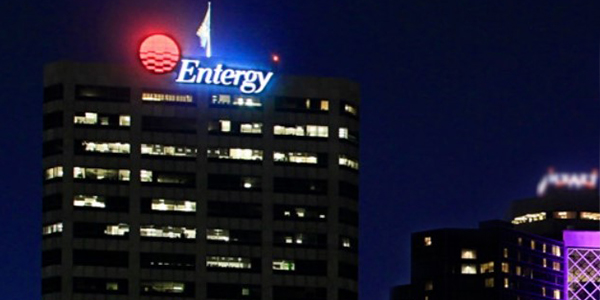By Amanda Durish Cook
Having met its current carbon reduction goal ahead of schedule, Entergy now says it plans to further slash emissions over the next decade to well below levels seen 20 years ago.
In a report issued Wednesday, Entergy said it is “intensifying” its efforts, pledging to reduce its CO2 emission rate to 50% below 2000 levels by 2030. If achieved, the company would produce about 24.6 million short tons of annual emissions, compared with 36 million short tons in 2017.
The announcement was rolled into Entergy’s 2018 Integrated Report, which combines the company’s annual shareholder report with its sustainability report. The company has already surpassed its previous commitment to reduce emissions to 20% below 2000 levels by 2020.
“The broad consensus of current scientific data on climate change indicates that, as an industry, we must do more to reduce our footprint and that of our customers and communities. Entergy sees this not as a choice but as a responsibility and an opportunity,” Entergy CEO Leo Denault wrote in a letter to stakeholders. “Speaking plainly, this means that for every unit of electricity we generate in 2030, we will emit half the carbon dioxide we did in 2000.”
In 2018, Entergy’s utility-only CO2 emission rate was 763 pounds/MWh, lower than the national average of 1,009 pounds/MWh. The 2018 emissions rate represented a 28% reduction from 2000.
Since announcing its portfolio transformation strategy in 2002, Entergy says it’s replaced almost 30% of its older generating assets. Natural gas-fired generation now represents 60% of the company’s more than 25 GW in generating assets.
While Entergy is not releasing a supply plan, it did say the new goal could mean a supply mix that’s 60% natural gas, 32% nuclear, 7% renewable and slightly more than 1% coal.
Entergy estimates it currently has about 1 GW of renewable projects in “various stages of development.”
Denault added that Entergy’s 8.8-GW nuclear portfolio is a “critical source of safe, large-scale and virtually emission-free baseload power” that could make or break the company’s sustainability goals. Preserving the plants is crucial, he said.
Those statements come at a time when Entergy is seeking to offload two nuclear units outside its service territory to a subsidiary of Holtec International. Entergy expects to complete the sales of the Pilgrim plant in Massachusetts by the end of 2019 and Palisades plant in Michigan by the end of 2022. The sales are part of the company’s strategy to exit the merchant power business and re-establish itself as a pure-play regulated utility.
Entergy also released a separate analysis and risk assessment on climate change. The company concluded it should focus on coastal wetland restoration, renewable generation, grid modernization, emergency response, energy efficiency and electric vehicles. It also said it’s designing facilities that can withstand flooding and extreme weather events.
The company is simultaneously planning for load reduction, as customers invest in distributed resources, and load growth, from increased demand for cooling and refrigeration. It expects climate change impacts to be “especially pronounced” in coastal Louisiana and Texas, where risks from sea level rise, damaging storms and coastal erosion are highest. The company also predicted “potentially disproportionate” impacts for its low-income customers.
None of the four states in Entergy’s utility service territory has passed carbon emissions regulations, though Texas has a renewable portfolio standard and New Orleans has published a climate action plan aimed at halving emissions by 2030. However, Entergy predicts that a federal carbon tax will soon become a reality.
Entergy said it would hold off on making plans around any technologies it might adopt until they prove cost-effective.
“Some of the technologies viewed as necessary to reduce greenhouse gas emissions consistent with a 2-degree [Celsius] scenario do not exist today. Others currently are not commercially viable and would require significant resource investments to adopt at a scale that is cost-competitive with conventional generation resources,” Entergy said.
The company also said simply halving its total emissions by 2030 isn’t feasible. To meet a 50% net reduction in emissions by that time, the company said it would have to increase its zero-carbon generation from the current 37% of the fleet mix to nearly 55% by 2030. One analysis showed Entergy would have to add 9.8 GW of solar capacity and 5.3 GW of battery storage in order to achieve the reduction, a scenario the company deemed unrealistic.





